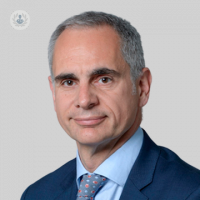Salivary gland tumours: all questions answered
Written by:The presence of salivary gland tumours may leave patients feeling concerned, anxious, and questioning if they are cancerous. Leading consultant ENT Head & Neck specialist Mr Ricard Simo addresses the questions and concerns that you may have about these tumours.
What are the symptoms of salivary gland tumours?
The majority of salivary gland tumours present as a lump in the salivary gland. The majority appear on the parotid gland (80%), which is the flat gland that is in front of the ear.

Only around 20 % of tumours arise from the submandibular gland, which is the gland just below the jawline on each side of the neck. There are other, smaller salivary glands inside the mouth, and the throat, but the development of tumours on these sides is relatively rare.
How are these diagnosed?
The majority of salivary glands tumours will present to a clinician, who will examine the patient, take their health history and palpate the lump.
Based on that, we would arrange an ultrasound-guided fine needle aspiration biopsy. With this method, tumours can be diagnosed very accurately, in around 90% of cases.
The clinician will also often, arrange for patients to have either a CT scan or an MRI scan. These are mainly for surgical planning and obviously for those patients who do have malignancy, these will serve as staging imaging.
How are salivary gland tumours treated?
Most salivary gland tumours are benign (80%), but will still often require treatment. Surgery is the treatment of choice, as these tumours will continue to grow and could potentially undergo malignant transformation.
This risk is approximately at a rate of 1% for every year that the tumour continues to grow. For malignant low-grade or low risk tumours, surgery may be sufficient, but for high-grade, or high-risk tumours malignant tumours, surgery, as well as adjuvant postoperative radiotherapy will be needed.
Are most salivary gland tumours malignant?
No, in fact, 80% of salivary gland tumours are benign, while only 20 % of the tumours of the partroid gland are malignant. In the submandibular gland, 50%. The smaller the gland, the more likely that the tumour is malignant. If a tumour arises from one of the minor salivary glands, which are scattered around the lining of the mouth and throat, up to 80 % of these tumours may be malignant, but overall the vast majority are benign.
Do benign salivary tumours need to be removed?
Yes, the majority will have to be removed. As previously indicated, these tumours although benign, will continue to grow, and then there is a potential risk of malignant transformation, which will require them to be removed.
Surgery is the treatment of choice for the majority of these tumours. However, in elderly patients, who may be frail or in certain types of tumours, such as Warthin’s tumours, they may not require surgical treatment. Instead, they can be kept under observation.
If you are concerned about salivary gland tumours and would like to book a consultation with Mr Simo, simply visit his Top Doctors profile today.


